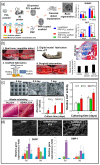Biopolymers and Their Application in Bioprinting Processes for Dental Tissue Engineering
- PMID: 37631331
- PMCID: PMC10457894
- DOI: 10.3390/pharmaceutics15082118
Biopolymers and Their Application in Bioprinting Processes for Dental Tissue Engineering
Abstract
Dental tissues are composed of multiple tissues with complex organization, such as dentin, gingiva, periodontal ligament, and alveolar bone. These tissues have different mechanical and biological properties that are essential for their functions. Therefore, dental diseases and injuries pose significant challenges for restorative dentistry, as they require innovative strategies to regenerate damaged or missing dental tissues. Biomimetic bioconstructs that can effectively integrate with native tissues and restore their functionalities are desirable for dental tissue regeneration. However, fabricating such bioconstructs is challenging due to the diversity and complexity of dental tissues. This review provides a comprehensive overview of the recent developments in polymer-based tissue engineering and three-dimensional (3D) printing technologies for dental tissue regeneration. It also discusses the current state-of-the-art, focusing on key techniques, such as polymeric biomaterials and 3D printing with or without cells, used in tissue engineering for dental tissues. Moreover, the final section of this paper identifies the challenges and future directions of this promising research field.
Keywords: 3D printing; dental tissues; polymers; tissue engineering.
Conflict of interest statement
The authors declare no conflict of interest.
Figures




References
-
- Kim T.G., Shin H., Lim D.W. Biomimetic scaffolds for tissue engineering. Adv. Funct. Mater. 2012;22:2446–2468.
-
- Galler K.M., D’Souza R.N., Hartgerink J.D. Biomaterials and their potential applications for dental tissue engineering. J. Mater. Chem. 2010;20:8730–8746.
-
- Jazayeri H.E., Lee S.-M., Kuhn L., Fahimipour F., Tahriri M., Tayebi L. Polymeric scaffolds for dental pulp tissue engineering: A review. Dent. Mater. 2020;36:e47–e58. - PubMed
Publication types
Grants and funding
LinkOut - more resources
Full Text Sources

